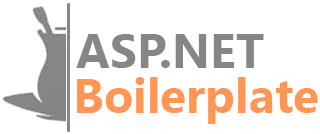In this document
ASP.NET Boilerplate can work with any O/RM framework. It has built-in integration with EntityFramework. This document will explain how to use EntityFramework with ASP.NET Boilerplate. It's assumed that you're already familar with EntityFramework in a basic level.
Nuget Package
Nuget package to use EntityFramework as O/RM in ASP.NET Boilerplate is Abp.EntityFramework. You should add it to your application. It's better to implement EntityFramework in a seperated assembly (dll) in your application and depend on that package from this assembly.
DbContext
As you know, to work with EntityFramework, you should define a DbContext class for your application. An example DbContext is shown below:
public class SimpleTaskSystemDbContext : AbpDbContext
{
public virtual IDbSet<Person> People { get; set; }
public virtual IDbSet<Task> Tasks { get; set; }
public SimpleTaskSystemDbContext()
: base("MyConnectionStringName")
{
}
protected override void OnModelCreating(DbModelBuilder modelBuilder)
{
base.OnModelCreating(modelBuilder);
modelBuilder.Entity<Person>().ToTable("StsPeople");
modelBuilder.Entity<Task>().ToTable("StsTasks").HasOptional(t => t.AssignedPerson);
}
}
It's a regular DbContext class except it's derived from AbpDbContext instead of DbContext. There are many overloaded constructors of AbpDbContext. You can use which you need.
EntityFramework can map classes to database tables in a conventional way. You even don't need to make any configuration unless you make some custom stuff. In this example, we mapped entities to different tables. As default, Task entity maps to Tasks table. But we changed it to be StsTasks table. Instead of configuring it with data annotation attributes, I prefered to use fluent configuration. You can choice the way you like.
Repositories
Repositories are used to abstract data access from higher layers. See repository documentation for more.
Default Repositories
Abp.EntityFramework implements default repositories for all entities defined in your DbContext. You don't have to create repository classes to use predefined repository methods. Example:
public class PersonAppService : IPersonAppService
{
private readonly IRepository<Person> _personRepository;
public PersonAppService(IRepository<Person> personRepository)
{
_personRepository = personRepository;
}
public void CreatePerson(CreatePersonInput input)
{
person = new Person { Name = input.Name, EmailAddress = input.EmailAddress };
_personRepository.Insert(person);
}
}
PersonAppService contructor-injects IRepository<Person> and uses the Insert method. In this way, you can easily inject IRepository<TEntity> (or IRepository<TEntity, TPrimaryKey>) and use predefined methods. See repository documentation for all predefined methods.
Custom Repositories
If standard repository methods are not sufficient, you can create custom repository classes for your entities.
Application Specific Base Repository Class
ASP.NET Boilerplate provides a base class EfRepositoryBase to implement repositories easily. To implement IRepository interface, you can just derive your repository from this class. But it's better to create your own base class that extens EfRepositoryBase. Thus, you can add shared/common methods to your repositories easily. An example base class all for repositories of a SimpleTaskSystem application:
//Base class for all repositories in my application
public class SimpleTaskSystemRepositoryBase<TEntity, TPrimaryKey> : EfRepositoryBase<SimpleTaskSystemDbContext, TEntity, TPrimaryKey>
where TEntity : class, IEntity<TPrimaryKey>
{
public SimpleTaskSystemRepositoryBase(IDbContextProvider<SimpleTaskSystemDbContext> dbContextProvider)
: base(dbContextProvider)
{
}
//add common methods for all repositories
}
//A shortcut for entities those have integer Id
public class SimpleTaskSystemRepositoryBase<TEntity> : SimpleTaskSystemRepositoryBase<TEntity, int>
where TEntity : class, IEntity<int>
{
public SimpleTaskSystemRepositoryBase(IDbContextProvider<SimpleTaskSystemDbContext> dbContextProvider)
: base(dbContextProvider)
{
}
//do not add any method here, add to the class above (because this class inherits it)
}
Notice that we're inheriting from EfRepositoryBase<SimpleTaskSystemDbContext, TEntity, TPrimaryKey>. This declares to ASP.NET Boilerplate to use SimpleTaskSystemDbContext in our repositories.
Custom Repository Example
To implement a custom repository, just derive from your application specific base repository class we created above.
Assume that we have a Task entity that can be assigned to a Person (entity) and a Task has a State (new, assigned, completed... and so on). We may need to write a custom method to get list of Tasks with some conditions and with AssisgnedPerson property pre-fetched (included) in a single database query. See the example code:
public interface ITaskRepository : IRepository<Task, long>
{
List<Task> GetAllWithPeople(int? assignedPersonId, TaskState? state);
}
public class TaskRepository : SimpleTaskSystemRepositoryBase<Task, long>, ITaskRepository
{
public TaskRepository(IDbContextProvider<SimpleTaskSystemDbContext> dbContextProvider)
: base(dbContextProvider)
{
}
public List<Task> GetAllWithPeople(int? assignedPersonId, TaskState? state)
{
var query = GetAll();
if (assignedPersonId.HasValue)
{
query = query.Where(task => task.AssignedPerson.Id == assignedPersonId.Value);
}
if (state.HasValue)
{
query = query.Where(task => task.State == state);
}
return query
.OrderByDescending(task => task.CreationTime)
.Include(task => task.AssignedPerson)
.ToList();
}
}
We first defined ITaskRepository and then implemented it. GetAll() returns IQueryable<Task>, then we can add some Where filters using given parameters. Finally we can call ToList() to get list of Tasks.
You can also use Context object in repository methods to reach to your DbContext and directly use Entity Framework APIs.
Note: Define the custom repository interface in the domain/core layer, implement it in the EntityFramework project for layered applications. Thus, you can inject the interface from any project without referencing to EF.
Repository Best Practices
- Use default repositories wherever it's possible. You can use default repository even you have a custom repository for an entity (if you will use standard repository methods).
- Always create repository base class for your application for custom repositories, as defined above.
- Define interfaces for your custom repositories in domain layer (.Core project in startup template), custom repository classes in .EntityFramework project if you want to abstract EF from your domain/application.

